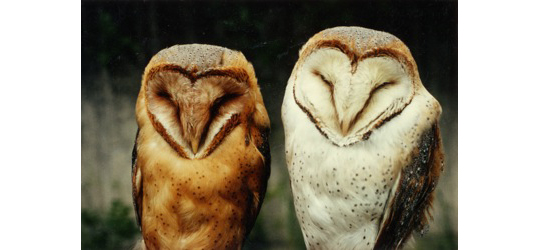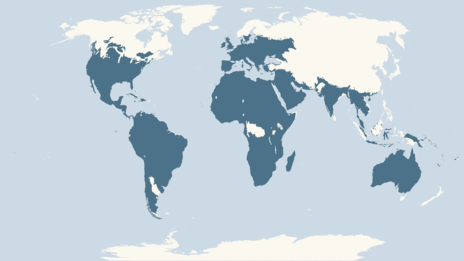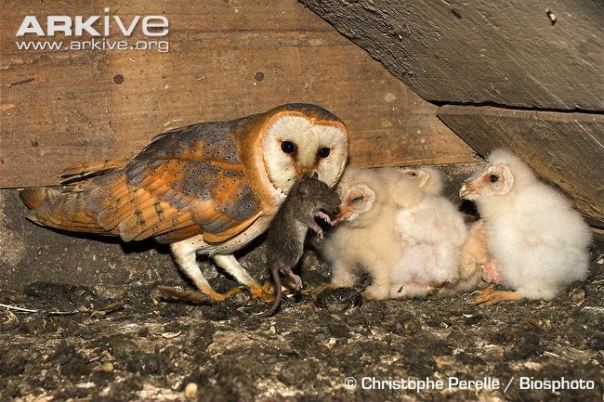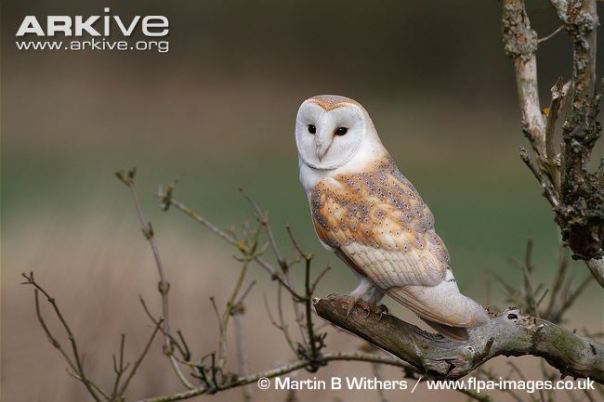- Name: Barn owl
- Latin: Tyto alba
- Classification: Bird
- Origin: Almost global
- Lifespan: 2-5 years
- AKA: Common barn owl, screech owl, white owl
Taxonomy
- Kingdom: Animalia (Animals)
- Phylum: Chordata (Vertebrates)
- Class: Aves (Birds)
- Order: Strigiformes (Owls)
- Family: Tytonidae (Barn owls)
- Genus: Tyto (Barn owls)
- Species: Tyto alba (Common barn owl)
Appearance
- Height: 25-40cm (9.8-15.7in)
- Wingspan: Up to 110cm (43.3in)
- Weight: F=570g (1.2lbs) M=470g (1lb)
The barn owl is a medium sized bird with a heart shaped facial disk whose coloring can vary greatly among subspecies. In the UK, the barn owl has pure white underparts with buff back and wings. However, the plumage can vary from pale brown to grey on its back and from white to reddish buff on its underparts. The bill can also vary from pale to dark and the talons from pink to pinkish-grey.
Males in general, tend to have fewer spots on the underside and are paler in colour than females. Males are also smaller than females and roughly 10% lighter. The nestlings are covered with white down with their facial disk becoming apparent soon after hatching.

Relatives
- Australian masked owl (Tyto novaehollandiae) -LEAST CONCERN-
- Western screech owl (Megascops kennicottii) -LEAST CONCERN-
- Great horned owl (Bubo virginianus) -LEAST CONCERN-
- Brown wood owl (Strix leptogrammica) -LEAST CONCERN-
Habitat & Distribution
The barn owl is the most widely distributed land bird in all the world, found on every continent except Antarctica. This species occurs throughout the majority of Britain and Europe, as well as Asia, African and much of North America (was introduced to Hawaii in 1958) and covers the entirety of Australia.
The barn owl was introduced to the Seychelles islands in 1949 to control rats on coconut plantations and now occurs as a problematic alien species on most of the islands, which prey on native animals such as fairy terns and the Seychelles sunbird. This situation is critical on the Aride Island (which is rodent free) where the owls will prey upon nesting seabird colonies. Pellet evidence collected from barn owls on this island have found remains of the brown noddy, which has since vanished from the island.
Barn owl populations can be found in rough grassland with good rodent populations and suitable roosting sites, such as field edges, watercourse edges and grass strips which run alongside woodland. Strips sown with Yorkshire fog and cocksfoot are good habitat for voles, which makes it ideal hunting ground for these owls.

Diet
The diet of barn owls in Britain and Ireland is made up primarily of rodents (90% of total diet) which includes short tailed voles, wood mice and common shrews. These birds are mainly nocturnal but have been known to hunt during dawn and dusk when they have young to feed and during the daytime at winter. Prey is usually swallowed whole and any parts the owl is unable to digest (such as teeth, bones and fur) is regurgitated as a pellet. These pellets are extremely useful to conservationists and researchers in understanding the diet and distribution of the barn owls.
Recent studies suggest that a single barn own requires 20-25km of field edges with suitable roosting sites to be able to hunt enough food for itself and any offspring. Strips sown with grasses such as Yorkshire fog and cocksfoot create a deep litter layer which is perfect for voles. Barn owls will normally hunt from exposed perches or during low flight and have the ability to find prey using sound alone due to their exceptional hearing.
The Shropshire Barn Owl Group has been collecting and analyzing barn owl pellets in the Shropshire area since 2002 and have documented 1,458 distinct prey items from 522 pellets collected from 69 sites. These studies have found that the field vole is the primary item of food for these birds making up 71% of the total diet. The following are wood mouse (12%), common shrew (9%) and bank vole (5%). The group also found pygmy shrew, house mouse, brown rat and birds, however, these account for less than 1% of the total items consumed.
Behaviour
Barn owls are nocturnal and can most commonly be seen flying at night or dusk over open fields with slow and silent wingbeat and a looping flight. They have excellent low light vision and can locate prey by sight in darkness, however, their ability to locate prey by sound alone is unequalled and is the best of any animal that has ever been tested. When threatened, the barn owl will spread its wings and move its head back and forth and will occasionally fall onto its back and strike at the threat with its talons.
Reproduction
Barn owls typically reproduce once a year (although two broods within a year have been documented) and will do so at any time of year depending on prey availability. Individuals will begin breeding at a year old and are most commonly monogamous (but there have been reports of polygyny). Courtship will begin with males making advertising calls and then chasing a female in flight, during which both will screech. The male will then display a ‘moth flight’, which consists of a male hovering in front of a perched female with his talons dangling beneath him for several seconds. The pair will then seek a nest site together (favoring old barns, nest boxes and tree hollows) and will copulate every few minutes. During copulation, the male will mount the female, grasp her neck and balance with outstretched wings.
Pairs will reuse old nests (some nests have been used repeatedly by different pairs for decades) rather than build a new one, and the female will line it with shredded pellets. Typically, 4-7 white eggs are laid at 2-3 day intervals with incubation lasting around 30 days. The chicks then hatch at 2-3 day intervals. The youngest of which may die if food is short as the mother will favor the elder chicks. 75% of chicks die within their first year with survivors living for another 1-2 years.
The female will leave the nest only briefly during brooding, living off food brought to her by the male. All brooding is carried out by the female and only she will feed the chicks on food brought to them by the male. During the first few weeks after hatching, the female will eat the chick’s feaces in order to keep the nest clean and to avoid altering predators to their nest location. Fledging will occur 50-55 days after hatching and will return to the nest to roost for 7-8 weeks after and will become completely independent 3-5 weeks after.

Adaptations
- Barn owls have very low wing loading, meaning they have large wings supporting a light body. This enables the bird to fly slowly without stalling and to hover.
- The heart-shaped facial disk of the barn owl directs sound towards the inner ear. The ears are positioned asymmetrically on either side of the head which means sounds are heard differently in each ear. This enables barn owls to locate prey using sound alone.
- The eyes are twice as light sensitive has humans and their low-light vision is highly movement sensitive. This means that anything that moves is instantly notices, helping the already keen hunting ability.
- The feathers are covered in thin hair-like structures which traps air on the surface, helping to avoid stalling while travelling at low air speeds. Also, the 10th primary has a row of tiny hooks which silences the sound of air hitting the wings edge – giving the barn owl silent flight.
Threats
Since the mid-19th century, barn owls have been in decline in Britain, originally due to persecution (during this time, it was widely believed that barn owls brought bad weather) and have suffered a decline of 70% since the 1930’s. This decline has continued into modern day due to a mix of factors including agricultural intensification, bad winters, road traffic accidents, pesticides and a loss of hunting and roosting sites.
2013 was the worst breeding season for barn owls in 30 years due to continuous bad weather since 2009 with only an average of 2 chicks per successful clutch. In Devon, of the 73 sites that were monitored, only 12% had nests down from 51% previously. 2012 saw the heaviest June rainfall since records began in 1910 and 2013 had the worst March snowfall in more than 30 years. This continuous bad weather hinders the breeding success of barn owls by killing of prey species (such as voles and mice) and waterlogging their feathers, making them unable to fly. The British Trust of Ornithology (BTO) recorded a 280% increase in reports of dead individuals during this year.
Loss of habitat affects barn owls as much as it affects any species. Suitable roosting, breeding and hunting sites are declining due to intensive farming methods and agricultural expansion. Newer and more intensive farming procedures results in less suitable land for the owls prey species which in turn, hinders breeding success. Old barns and hollow trees are also disappearing due to decay and general ‘tidying up’ of the countryside resulting in less suitable roosting and breeding sites.
Other threats to barn owls include sudden exposure to bright lights (such as car headlights) which can cause temporary visual impairment which more often than not leads to road traffic accidents. Barn owls also fall prey to natural predators including buzzards, eagle owls and goshawks, while mammalian carnivores (weasels and stoats) will occasionally take chicks and eggs.
Conservation
- IUCN Status: Least Concern
- Population Trend: Stable (since 2002)
The barn owl is protected under schedules 1 and 9 of the Wildlife and Countryside Act 1981, which makes it illegal to kill, injure or take a wild barn owl or to remove or damage their eggs. They are also classed as a species of conservation concern by the UK Biodiversity Action Plan (although they are not a priority species) and are classed as medium conservation concern by the Birds of Conservation Concern Amber List. The Hawk and Owl Trust also run a project called the Barn Owl Conservation Network (BOCN) which promotes suitable habitat creation and the erection of nest boxes.
Fun Facts
- Male: Male owl
- Female: Female owl
- Young: Chick, owlet
- Group: Flock, parliament, brood, diss, nest, looming, wisdom
- In Spanish, male owls are called buho and females, lechuza.
- Barn owls never hoot, instead they screech.
- They weigh about as much as a grapefruit.
- Old names for the barn owl include demon owl, death owl, ghost owl, hobgoblin and old hushwing.
- They used to be killed and nailed to barn doors to protect against thunder and lightning.
- In the 20th century, owl window were built into stone barns to encourage barn owls to nest, as they would eat rodents and prevent crops from being eaten.
References
All About Birds (2015) Barn Owl [Online] Available at: http://www.allaboutbirds.org/guide/Barn_Owl/lifehistory [Accessed: 3 September 2015]
Arkive (2015) Barn Owl (Tyto alba) [Online] Available at: http://www.arkive.org/barn-owl/tyto-alba/ [Accessed: 5 September 2015]
Barn Owl Centre (2015) Barn Own Diet [Online] Available at: http://www.barnowl.co.uk/page21.asp [Accessed: 22 July 2015]
Batchinski and Harris (2002) Tyto alba – Barn Owl [Online] Available at: http://animaldiversity.org/accounts/Tyto_alba/#reproduction [Accessed: 4 September 2015]
BBC (2014) Barn Owl [Online] Available at: http://www.bbc.co.uk/nature/life/Barn_Owl [Accessed: 19 June 2015]
Davies, C (2013) Britain’s Barn Owls Under Threat Due to Extreme Weather [Online] Available at: http://www.theguardian.com/environment/2013/aug/01/barn-owls-threat-extreme-weather [Accessed: 5 September 2015]
IUCN (2002) Tyto alba [Online] Available at: http://www.iucnredlist.org/details/22688504/0 [Accessed: 6 September 2015]
Nature Works (2015) Barn Owl – Tyto alba [Online] Available at: http://www.nhptv.org/natureworks/barnowl.htm [Accessed: 3 September 2015]
RSPB (2015) Barn Owl [Online] Available at: http://www.rspb.org.uk/discoverandenjoynature/discoverandlearn/birdguide/name/b/barnowl/ [Accessed: 19 June 2015]
Shropshire Barn Owl Group (SBOG) (2015) The diet of the barn owl in Shropshire [Online] Available at: http://shropshirebarnowlgroup.org.uk/diet-of-the-barn-owl-in-shropshire.php [Accessed: 22 July 2015]
The Barn Owl Trust (2015) Barn Owl Adaptations [Online] Available at: http://www.barnowltrust.org.uk/barn-owl-facts/barn-owl-adaptations/ [Accessed: 4 September 2015]
The Barn Owl Trust (2002) Barn Owls on Site: A Guide for Developers and Planners [pdf] Available at: http://www.lbp.org.uk/downloads/Publications/PlanningGuidance/NE_barnowls.pdf [Accessed: 6 September 2015]
The Owl Pages (2015) Owls: Species: All [Online] Available at: http://www.owlpages.com/owls.php?genus=all [Accessed: 19 June 2015]
Wikipedia (2015) Barn Owl [Online] Available at: https://en.wikipedia.org/wiki/Barn_owl [Accessed: 19 June 2015]
Williams, G (2011) 100 Alien Invaders. UK, Brandt Travel Guides. USA, The Globe Prequot Press.
